By Guangming Daily Research Team
The vast land of Xinjiang boasts three mountain ranges and two basins. It stretches as far as eyes can see, to places where lush pastures extend to horizon. Countless flocks and herds roam on the green land, where Chinese of all ethnic groups join hands to transform Gobi deserts into oasis, adding vitality to the beautiful land of Xinjiang.
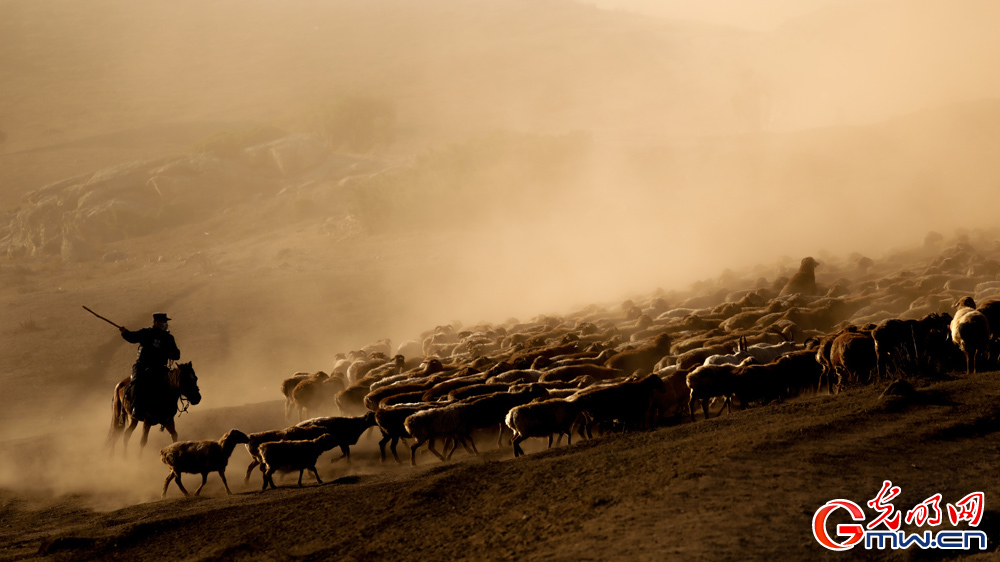
A policeman helps local herdsmen herd sheep in Altay, northwest China's Xinjiang Uygur Autonomous Region, September 3, 2022. (Photo/ Guangming Picture)
The ancient Silk Road that connected then Chinese capital Chang’an and Rome ran through Xinjiang. The vicissitudes of times have seen camels criss-crossing endless deserts, and the sun setting behind the mountains far away. Our great forebears, adventurers and explorers alike, left their footprints in trade and cultural exchanges on the mysterious land of Xinjiang, triggering endless imaginations for future generations.
It was here that Lin Zexu, a famous patriot, the loyal minister of the imperial court in Qing Dynasty who fought the opium trade, lived in exile after being sacked. Lin left to us the famous poem that “I shall dedicate myself to the interests of the country in life and death, irrespective of personal weal and woe”. Lin’s footprints covered both sides of the Tianshan Mountains, prospecting the territory, encouraging agricultural activities, dredging Kan’er wells and leaving behind legacies that benefited one generation after another.
It was here that a battalion of Han Dynasty troops took off their military uniforms and settled down for development. They buried the hatchet and turned swords into plowshares, transforming farming villages into cities. They were defending national borders and the ecosystem here. Today, the Xinjiang Production and Construction Corps have taken up a similar role, becoming modern-day “boundary markers” that will never fade away.
It was from here that enchanting melodies spread across the country and became tunes that echo in the hearts of generations of Chinese. Household songs such as the “The Girl of Darban City”, “Alamu Khan”, “Why Are the Flowers So Red”, “Xinjiang is a Good Place”, “The Grapes of Turpan are Ripe” and the “The Shepherd of Koktokay” are odes the beauty of this land, and the infinite love of the Chinese people for Xinjiang.
Xinjiang, with its exotic scenery, bountiful produces, unique charm and ever-changing looks, has drawn the attention of the world.
Unfortunately, exactly because of its vastness, many people have failed to see its full picture; and few have been there because it sits so far away in the hinterland of the Eurasian Continent. Worse still is the fact that people with ulterior motives are pouring dirty water on Xinjiang ...
Then what does Xinjiang really look like today?
The Guangming Daily research team recently paid a visit to Xinjiang, walking into its streets and communities, and villages and towns, to find out how the locals live and work, and how they perceive the changes that have taken place.
Let’s start the journey and walk into a real, full-dimensional Xinjiang.
I
With great virtue comes great success. Labor has nourished our virtue and shaped the landscape of the places we live. For thousands of years, people of all ethnic groups in Xinjiang have explored the land under their feet with hard work and diligence. Today, people in Xinjiang are passing on this spirit. Every ethnic group and every worker deserves a solemn salute, for they have created a prosperous Xinjiang under the leadership of the Communist Party of China.

A volunteer helps local farmers pick grapes at a village in Awat County, northwest China's Xinjiang Uygur Autonomous Region, July 20, 2022. (Photo/ Guangming Picture)
Against the scorching heat of the vast Gobi in the west of Aksu, we walked into a 65,000-mu (4,333-hectare, or 10,708-acre)fruit orchard of Hongqipo Group in late June. It seemed as if we could hear the sizzling sound of apples, pears and grapes turning juicy and sweet under the sun.
According to He Zhangwei, technical director of the orchard, only 50 workers are needed to manage the entire orchard. The whole process is mechanized, which improves the efficiency by 90% and reduces the cost by 90%. “Now we use tree planters, machine ploughs, straw crushers and electric, intelligent and driverless tractors.” He pointed to the drone flying over and said, “This is our drone supported by the Beidou navigation system and it’s spraying fertilizer now. All you need is to mark the longitude and latitude of the orchard on your phone, and the drone will take care of the rest.”
With two basins sitting in between three mountain ranges, Xinjiang is blessed with over 100 million mu of arable land, where large agricultural equipment can be used to great effect. “Science and technology” have become the highlight of Xinjiang’s agriculture, where the mechanization rate for main crops has reached 85.48%.
In Wensu County–Xinjiang’s key cotton producer in Aksu Prefecture, hundreds of thousands of acres of cotton is blossoming with milky white, light pink, and light yellow flowers. Although cotton-picking season has not yet arrived, standing here, one can imagine the spectacular harvesting scene in autumn.
The ample sunshine, warm wind, and the water melted from snow are blessings for cotton. Quality of the cotton produced here is second to none in the world: the cotton lint is long and soft, and the color is pure and clean. The long-staple cotton in Xinjiang not only has good looks, it’s highly elastic, durable and wear-resistant. Its fiber is 35% longer than that of ordinary cotton. The air permeability of cloth made of Xinjiang cotton is 5 times that of ordinary cotton. Cotton production in Xinjiang accounts for 89.5% of China’s total, and 20% of the world’s.

A cotton picker is seen working in fields in Aksu Prefecture, northwest China's Xinjiang Uygur Autonomous Region, Sept. 26, 2022. (Photo/ Guangming Picture)
“Cotton farms nowadays are increasingly less reliant on human labor. Machines get to do most of the job from plowing the land to picking the cotton. You’d see if you come in autumn, that cotton-picking machines neatly line up in a row, the entire farm could be harvested with only a few round trips. It is such an enjoyable scene. Last year I earned nearly 3 million yuan, and labor cost was only a fraction of that”, said Manuti Daouti, a cotton farmer who planted 3,000 mu of cotton.
Aymel Tulhong is a large cotton farmer in Xayar County of Aksu Prefecture. Last year, his planting area exceeded 1,900 mu thanks to the alluring income from the cotton business. “Cotton picking was completed within one week, and I earned over 1 million yuan because of these machines”, he said.
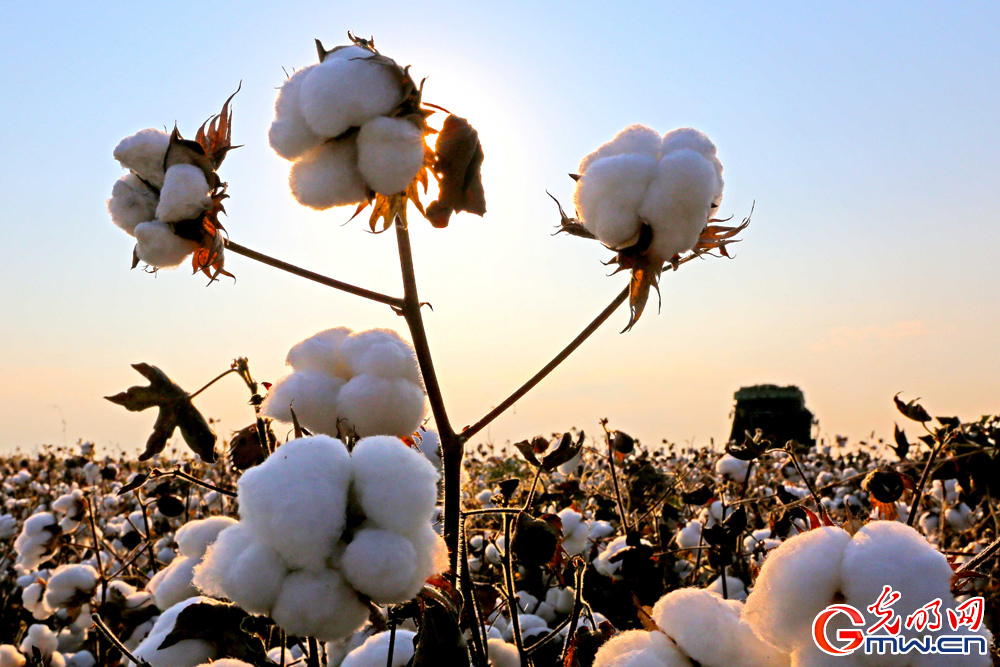
Photo taken on Oct. 4, 2021 shows cotton fields at Northwest China's Xinjiang Uygur autonomous region. (Photo/ Guangming Picture)
Statistics show that the mechanized harvesting rate of cotton in 2021 exceeded 80%, and 95% of the cotton in northern Xinjiang was picked by machinery.
There are also some small plots not suitable for mechanized picking and need to be picked by hand. However, in Xinjiang, hand-picking is an attractive job due to the lucrative pay. In the two-month harvesting season, not only locals in Xinjiang rushed to the job, cotton pickers from Shandong, Henan, Gansu and other parts of the country would also join the silver-hunting game. A skilled cotton picker can earn more than 20,000 yuan in two months. Maimaitimin Atagula, a local farmer in Hotan, said that last year he and his wife earned nearly 20,000 yuan after working 40 days in Aksu. “We’re definitely going again this year”, he said.
Our reporters heard this Uygur proverb along the trip: “The hard-working get to eat lamb leg, and the lazy drink cold water.” On both sides of Tianshan Mountains, working has become a spontaneous choice for people of all ethnic groups in Xinjiang. The people of Xinjiang today are creating happy lives by doing decent jobs of their voluntary choice.
Statistics show that in 2021, the per capita disposable income of urban residents in Xinjiang exceeded 37,000 yuan, and for rural residents, the figure exceeded 15,000 yuan, both had grown more than 100 times from that of 1978. Today, 2,020 service stations for outdoor workers and 4,622 lounges and breastfeeding rooms for female workers have been built in industrial parks with a high concentration of workers.
Xinjiang Siwei Textile Company is a cotton enterprise that came into operation last year in Aksu’s Awati County. Buyhemuti Toheti, head of the company, said with anger: “Some people are so jealous that they smear Xinjiang with ‘forced labor’. They must be thinking with their toes: why would anyone force us to pursuit a happy life?”
The white cotton is the “flower of happiness” for the people in Xinjiang. In the United States, however, there is a dark history of forced labor associated with cotton. The white cotton in southern US was once soaked with the blood and tears of black slaves – it’s a sin that the US can never wipe off.
Black slaves, inadequately clothed and fed, exhausted all their strength for cotton picking under guns and whips. In 1860, cotton production in the US was 130 times what it had been in 1800, behind which was the unimaginable physical and mental devastation of the blacks.
The value of labor squeezed from black slaves by American slaveholders amounted to $14 trillion in current prices. According to statistics, in 1850, 80% of US exports were produced by slaves. It was slavery, rather than democracy, that paved the US and West’s way to prosperity.
Even today, US immigration law remains supportive of modern slavery, and there is a strong correlation between certain visa types and forced labor. Studies have shown that over 70% of victims of forced labor in the US arrived with a legal visa.
To this day, there are still some 500,000 child labors in the US working in agriculture. Many start working from 8 years old, working for up to 72 hours a week. Between 2003 and 2016, 237 child labors died in agricultural accidents in the US, according to US media.
Cotton, flawlessly white and pure, is nature’s blessing to Xinjiang. To boycott Xinjiang’s cotton is to reject the gift from nature.
The so-called “Uyghur Forced Labor Prevention Act” shows how the US is blatantly meddling in Xinjiang’s affairs, and flagrantly interfering with China’s internal affairs to achieve the goal of “containing China with Xinjiang”. This is a manifestation of bullying and hegemony, and a dangerous, provocative move.
But how can anything ever be achieved by inciting the boycott of Xinjiang’s cotton?
An overseas netizen once launched a challenge to “reject Made-in-China products”, and the result was a bleak one: the challenger ended up running almost naked on the street, wrapped only in a green bath towel.
This is not to say that China is unstoppable, but rather, we live in a global village and are bonded together in one way or another. Xinjiang’s cotton has been warming our day-to-day life, and it’s not something that people can cut off easily. The question for those Western politicians demanding the boycott is, are you ready for a “naked run”?
II
“People love it and want to come again”, “My WeChat wallet is getting thicker by the day”, “Education is increasingly improved with greater equity”, and “Life is getting better every day” … in the eyes of people living in Xinjiang: no political party in the world is like the CPC, who puts its people in the most important position.

A dancer performs traditional dance in Hami City of northwest China's Xinjiang Uygur Autonomous Region, Aug. 2, 2022. (Photo/ Guangming Picture)
Daoxiang Village in Hotan County’s Aizhiq Town sits in the very south of the Taklamakan Desert. It’s a “celebrity village” on Douyin, the Chinese edition of TikTok. According to locals, it’s a village that tourists, both adults and kids, would “fall in love with instantaneously and would definitely come again”.
The village gives us far more surprises than on the short video app.
Open gardens, exotic housing styles with painted eaves and carved patterns on window frames, who would reject an invite to sit down on a large, cool carpet under the shady grapevines, not to mention the temptation of crisp noodles, nang breads, yogurt, peaches, milk tea and watermelons. In the hot sun, nothing is more soothing than sitting in the shade in the breeze, tasting a wide variety of snacks while enjoying the beautiful view of the endless paddy fields.
In recent years, Party committees and governments at all levels in Xinjiang have prioritized the construction of beautiful and livable villages for rural revitalization, Daoxiang Village has developed its tourism business such as special cuisine. agritainment, embroidery workshops, and home-hostels. Appealing to tourists, traditional elements such as nang stoves and local barbecues have also retained the historical culture and local flavors.
With the aroma of lamb, carrot and rice coming all together, and her four grandchildren playing under grapevines, 52-year-old Awanisha told reporters that her family’s 5 mu of paddy field was rented to the cooperative, “Now we have turned from farmers to bosses, and when business is good, the monthly income from home-hostel could exceed10,000 yuan, the money just keep flowing in!”
The new village of Jinhua in Wensu County, located in the northwest of the Taklamakan Desert, gives people a strong south-China feel. A large lake is decorated with lotus leaves and flowers, and the paddy field along the bank leads you to a walkway under grapevines that connects to a south-China styled compound. It’s actually a village of more than 2,400 people, who had relocated here under the one-on-one aid program in partnership with Zhejiang’s Jinhua City. More than 80% of the villagers are Uygurs, and the per capita annual income from special agribusiness and countryside tourism reached nearly 20,000 yuan.
Graduated from the Shanghai Institute of Finance, 25-year-old Maier Haba Tursun told reporters that she first tried job-hunting in Shanghai, but then chose to return home after seeing how beautiful her hometown had become. She set up her own business of walnut and black honey processing, and an agritainment hostel. “I don’t think there’s any difference from living in the coastal regions in eastern China. Here every family has a car, and many are driving expensive SUVs”, she said.
Thirty-one-year-old Abdul Aini Tursun is a successful businessman in his village: he’s running a successful agritainment business as he learned cooking before. Now he owns a grape- and fig-picking garden. Plus, he has contracted 40 mu of walnut trees. “Thanks to the Party’s supportive policies, my WeChat wallet is getting thicker by the day, it’s exciting to see the number grow so fast”, he told reporters.
If human rights protection is an integral part of the beautiful landscape in Xinjiang, then the highlight is the protection of human rights of women and children.
Thirty-six-year-old Semyhe Elken is an entrepreneurial woman from the ancient city of Kashgar who is dedicated to the business of beauty. She returned to her hometown after graduating from the Capital University of Economics and Business in Beijing. She dreamed of putting on a white wedding dress when she got married in 2010, but had to drop the idea because of strong opposition from her relatives. In 2012, she decided to open a wedding dress store, and the Municipal Women’s Federation assisted with a start-up fund. Now Semyhe designs wedding dresses that are highly sought after by young women because of the combination of fashion elements and ethnic styles. Her business is getting bigger and bigger, and today she is already the chairwoman of a cultural media group.
Mayerzej Kurban is 14 years old, a first-year student at Shanshan County No. 1 Middle School in Turpan. She became known as the “Desert Soccer Girl” after a documentary titled “Beyond the Mountains” went viral in 2021. She secretly joined the school’s girls’ soccer team as a 4th-grader in primary school despite her mother’s objection. Playing in the desert and running on the field, soccer made her lively and cheerful. Her wish, in her own words, is to become a “sonorous rose” in full bloom. At its heyday, the country’s national team of female soccer players got the collective pet name “sonorous roses”.
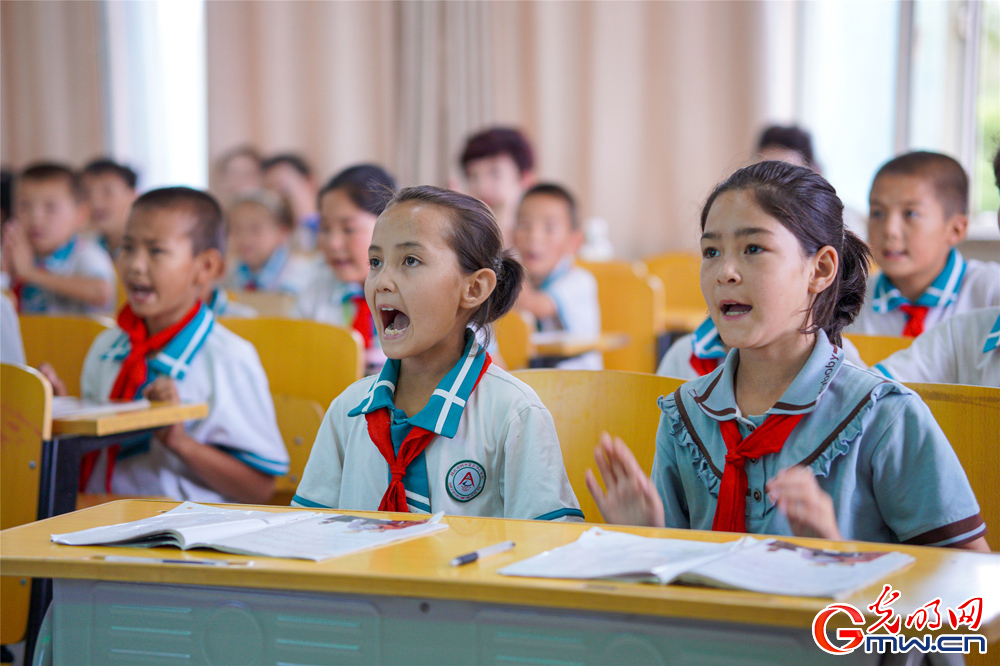
Children are in class at a school in northwest China's Xinjiang Uygur Autonomous Region, June 16, 2022. (Photo/ Guangming Picture)
Education is a pathway to modernization for ethnic minorities. From the full coverage of the nine-year compulsory education in Xinjiang, to the 15-year free education in southern Xinjiang, education in Xinjiang is progressing towards greater equity and higher quality.
Kulban Niyazi, 58, is the principal of the Mandarin Primary School in Imaamu, a small town in the border area of Ushu County, Aksu Prefecture. Believing firmly that Mandarin could end the seclusion and bring modern life to local villagers, he returned to his hometown 20 years ago and took out all his savings of 600,000 yuan to set up the Mandarin school, which turned out to be a game changer for the village. The majority of the more than 700 graduates have been admitted to middle schools, some have been admitted to Tsinghua and other prestigious universities, and some even went abroad for further studies. His wish is to light up the beacon of hope for rural boys and girls so they, too, can achieve their dreams.
Wensu County is building a new school covering an area of 279 mu, with a building area of nearly 130,000 square meters, which allows students to study for 12 years straight. In September, the first batch of students will arrive, and Kurban Niyazi, a Mandarin education enthusiast, will serve as their principal.
Traveling across the mountains and deep into the grasslands and Gobi deserts, we saw that Xinjiang’s beauty is shaped by its respect for human rights. As of the end of 2020, all 3,064,900 rural poor in Xinjiang under the current standard had been lifted out of poverty, all 3,666 poor villages and the 35 poor counties had been removed from the list. Over the past 60 years since the establishment of the Xinjiang Uygur Autonomous Region, the total Uygur population has grown from 2.2 million to about 12 million, and average life expectancy has increased from 30 to 74.7 years.
There is no political party in the world that places the people so central in its heart and works for their well-being with such deep affection as the CPC does.
In contrast, how hypocritical and shameful are those American politicians who keep talking, and only talking, about human rights! They’d better look at themselves in the mirror and see behind them the long list of poor human rights records:
As Covid-19 rages all over the world and people demand real fight against the virus, the US government is busy shifting the blame while showing no regard to the lives of its own people. To date, there have been more than 1.06 million deaths in the country, the highest in the world.
Campus shootings are a frequent occurrence and have become a lingering nightmare for elementary and middle school students and teachers. Last school year alone, there were 146 campus shootings in the US. Just as politicians were playing their partisan games, another shooting took place at a Texas elementary school in May, taking 21 lives.
Once calling itself “heaven for immigrants”, the US has been detaining immigrants indiscriminately. In recent years, it has detained 266,000 immigrant children, forcibly separating them from their parents, and many immigrant families were cruelly torn apart.
The US has waged wars and slaughtered civilians, seriously undermining the right to life and survival. In the past 20 years, more than 250,000 civilians died in the wars in Afghanistan and Iraq. At least 350,000 people have lost their lives in Syria as a result of US military involvement.
While we were in Xinjiang, a horrific story was reported by a Western media outlet, exposing the massacre of civilians by British forces in the war in Afghanistan. An entire Afghan family could be ruined simply because they looked suspicious.
Bishara Aishanhali, an official from Xinyuan County, said with a serious look on his face: “The tragedy in our neighboring country is really heartbreaking. With the strength of the motherland comes peace in Xinjiang; when Xinjiang enjoys stability, people of all ethnic groups here can live to their fullest”.
Well said it is, but one will gain a better understanding by walking deep into Xinjiang that “human rights” are not designed as a decoration, rather it’s an enabler for people’s pursuit of a better life.
III
The coexistence of multiple religions is a historical feature of Xinjiang, where different religions mingle and co-exist in peace and harmony. The peaceful and tranquil environment allows people to enjoy the solace of faith in their heart. Today, the freedom of religion in Xinjiang is unparalleled in any historical period.
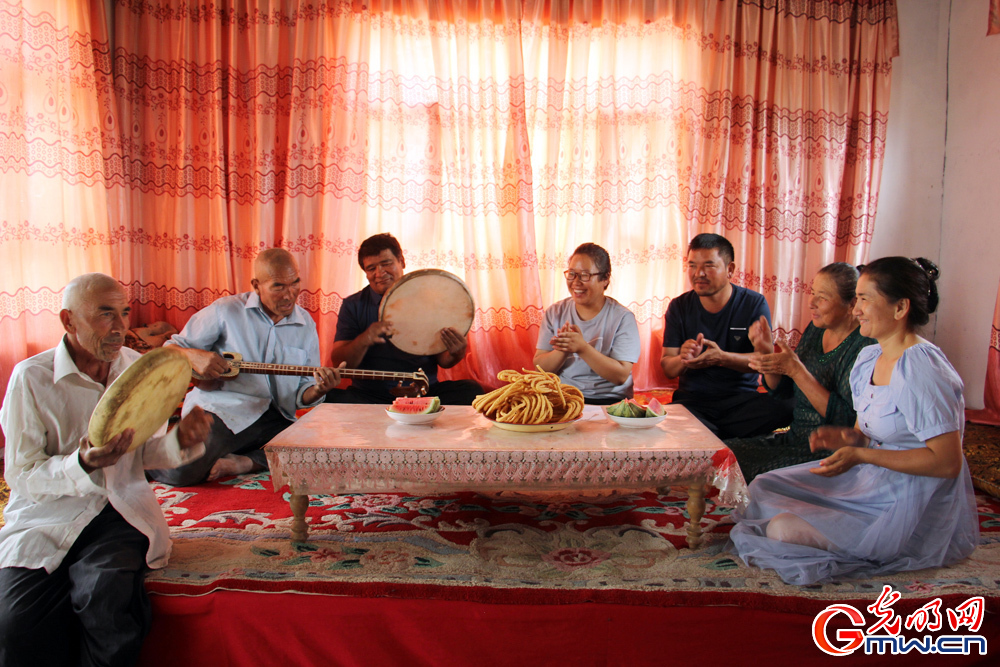
People sing together to celebrate the Corban Festival in Awat County, northwest China's Xinjiang Uygur Autonomous Region, July 10, 2022. (Photo/ Guangming Picture)
Shortly before our trip, Michelle Bachelet, the UN High Commissioner for Human Rights, visited Xinjiang, triggering an uproar in the West.
Renowned religious leaders in Xinjiang have recently written by email to Bachelet, expressing their firm confidence that freedom of religious belief is guaranteed in Xinjiang in accordance with the law.
In the letter, Abdurekhev Tumuniyaz, president of the Xinjiang Islamic Association and director of the Xinjiang Islamic Scripture Institute, wrote that in Xinjiang, all legal religious activities in religious places and in people’s own homes according to religious customs, such as worshiping, fasting and celebrating religious holidays, are taken care of by religious groups and believers themselves, and are protected by law. No organization or individual may interfere.
Vice president of Xinjiang Islamic Association Hatifu Abhisan Tursunyaz, from Hotan’s Gabai Mosque, wrote that in the past few years, the local governments built, relocated and expanded some mosques, therefore the mosques today feature a more reasonable layout, they’re also much safer and more popular in the religious community and believers. At present, the mosques in Xinjiang are fully able to meet the needs of the religious masses.
Imam Muhatirem Xirifu, another vice president of Xinjiang Islamic Association from the Yangxing Mosque in Urumqi, wrote that religious sites in Xinjiang continued to improve, mosque infrastructure was modernized with a full range of equipment, which brought greater convenience to believers.
The facts stated in these letters and the views expressed are widely supported by the religious community in Xinjiang.
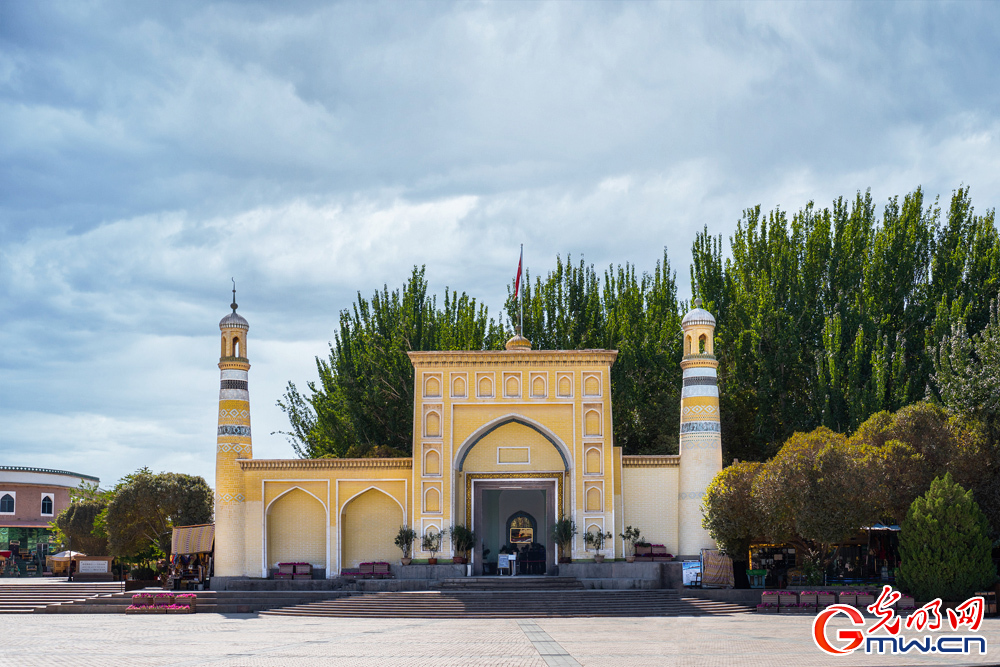
Photo shows the Id Kah Mosque in Kashgar, northwest China's Xinjiang Uygur Autonomous Region. (Photo/ Guangming Picture)
With a history of nearly 600 years, the Id Kah Mosque stands in the bustling downtown area of Kashgar and is the largest mosque in Xinjiang. We met there with vice president of the Xinjiang Islamic Association Maimati Guma, who was from the Etigar Mosque.
Maimati Guma began by telling us, “On July 15, I had the honor of meeting and having a photo taken with General Secretary Xi Jinping, who came to Xinjiang for a visit. I was introduced to him by Chairman of the autonomous region, Elkun Tuniyaz. General Secretary Xi greeted me with a big smile. At the time I was so excited that I burst into tears.”
“Later I saw on TV that the General Secretary said that we should adhere to the direction of localizing Islam and adapting it to the socialist society. I was deeply educated. And as religious figures, we must remember General Secretary Xi Jinping’s ardent wish, always feel the Party’s benevolence, listen to the Party, follow the Party, and unite all believers firmly around the Party and the government,” said the emotional Maimati Guma.
Maimati Guma was born in the 1970s. His father, Guma Tayir, used to be the imam of the Etigar Mosque, who was committed to preaching the Islamic concepts of peace, solidarity, moderation and tolerance. Eight years ago, he was killed in a brutal attack by a mob outside the mosque after finishing the morning rituals.
“I was more than saddened by my father’s death, then I became more determined than ever to carry on my father’s legacy and be a patriotic religious figure. The teachings of Islam advocate that Muslims and people of all races must live in harmony and obey the law. I want all believers to abide by Islamic rules, embrace peace, unity and resist extremism.”
According to Maimati Guma, the Party and the government have spent a lot of money to restore the Etigar Mosque to its past glory. “They care about religious people in their life, work and political participation, and I was elected as a deputy to the National People’s Congress, so I have to live up to the trust of the people; they also attach importance to cultivating more religious figures, and there is a group of young believers ranging from their 20s to 30s in my mosque as well as the mosques around us”, he said.
“I get up every morning at 6 a.m. to go to the mosque and lead the morning rituals. Then I go to the library at the mosque to read books, mainly religious and Mandarin books. I now spend much time to learn Mandarin with the help of cell phone software and dictionaries, and I hope that the next time you come back, I will be able to converse in more fluent Mandarin.”
Deputy Imam Abbas Mehmeti of the Etigar Mosque also happily accepted our interview. He went right to the point: people of all ethnic groups in Xinjiang fully enjoy the freedom of religious belief, and people are completely free to choose between believing and not believing in Islam. Their freedom has been respected in the past and at present.
We also visited other famous mosques in Xinjiang: the Urumqi Yangtsing Mosque, Hotan Gabai Mosque, Yili Baidullah Mosque, Yining Hui Grand Mosque, and Aksu Maigulan Mosque. We’ve seen people worship at regular times of the day. Although we could not understand their prayers, we could feel their inner peace and freedom from their calm and pious expressions.
When looking at religious freedom in a country or region, we have to comprehensively look at its religious policy, its social environment, and the state of believers. In Xinjiang today, people of different ethnicities are living happily in peace, harmony, solidarity and social stability thanks to appropriate religious policies.
Abdurekhev Tumuniyaz, president of the Xinjiang Islamic Association and director of the Xinjiang Islamic College of Scripture, said “Allah gave us two ears and two eyes so that we can hear and see more; but he gave us only one mouth, so we should speak with factual truth. Today, the freedom of religion in Xinjiang is unparalleled in any historical period in the past.”
To draw a simple comparison, the number of Muslims in the US is 1/3 of that in Xinjiang, while the number of mosques is 1/10 that of Xinjiang. Freedom of religion is seriously infringed upon in the US and discrimination and persecution against Islam are omnipresent.
Islam is the most discriminated religious belief in the US. According to surveys, 82 percent of Americans believe that Muslims are discriminated against in the country, and 63 percent agree that believing in Islam would stifle opportunities for personal development in American society. Hate crimes against Muslims amount to the hundreds each year. Shortly after winning presidential election, Donald Trump signed the notorious “Muslim Ban”. The US has spared no effort to spread the “Islamic threat" theory around the world, stigmatizing Islamic civilization and labeling it as “backward”, “terrorist”, “violent”, etc. This has seriously damaged the national dignity and international image of Islamic countries, and violated the personal freedom and religious belief of Muslims.
Worse still, the US has set up covert prisons overseas in the name of counter-terrorism, arbitrarily detained hundreds of thousands of Muslims. In Afghanistan, detainees were subjected to “torture, abuse, rape and sexual violence”. The Quran was desecrated to damage the will of Muslim prisoners, no prisoner’s dignity was respected given the reckless torture and cruelty they endure.
IV
The beauty of Xinjiang lies in its bountiful land and diverse ethnic culture. In Xinjiang, one can easily encounter an intangible cultural heritage from a different ethnic group. Only on a land of respect, love and compassion, can culture and civilization flourish as such in Xinjiang.
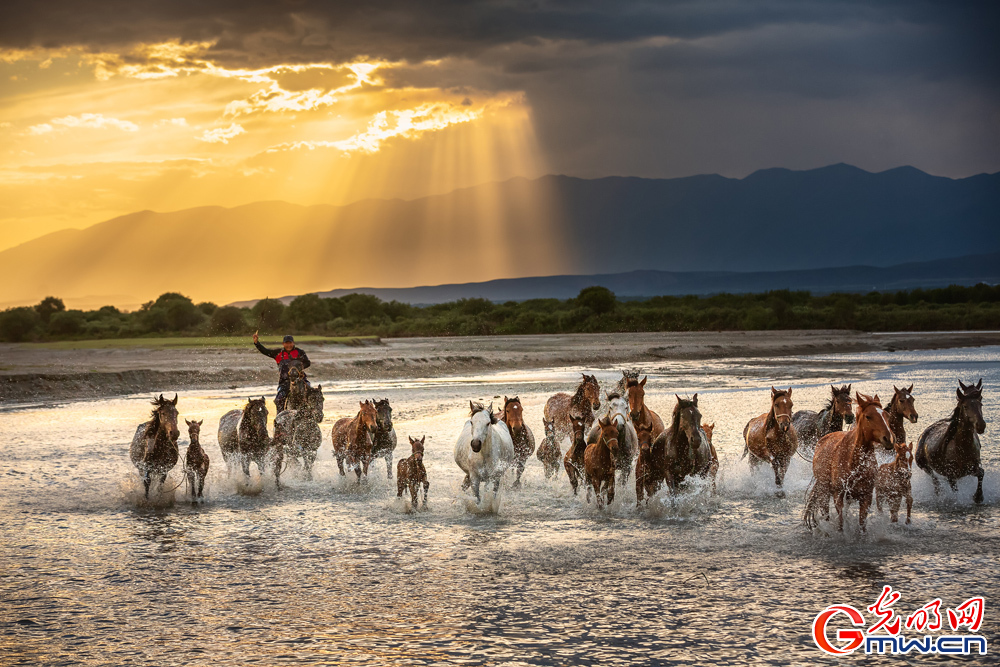
A drove of horses gallop in a river in Zhaosu County, Kazak Autonomous Prefecture of Ili, northwest China's Xinjiang Uygur Autonomous Region. (Photo/ Guangming Picture)
“Song and horse are the two wings of the Kazakhs.” Following this ancient Kazakh proverb, we set out from Horgos, drove more than 380 kilometers along the Kungnaisi River valley under the scorching sun to the Nalati Grassland for Kazakh horses and songs.
Nalati Grassland is located in Xinyuan County, Ili Kazakh Autonomous Prefecture, in the hinterland of Tianshan Mountains and the eastern end of the Ili River Valley. The average altitude of grassland is 1800 meters, covering a total area of 1,840 square kilometers, it is known as “grassland in the air”. It’s here that one can appreciate the beauty of all four seasons at one glance: in the distance sits the snow-capped mountains, at the foot of the mountains are dense pine forests, and right before your eyes are the pasture in a river valley. No wonder people say the best grassland sits in Xinjiang’s Nalati!
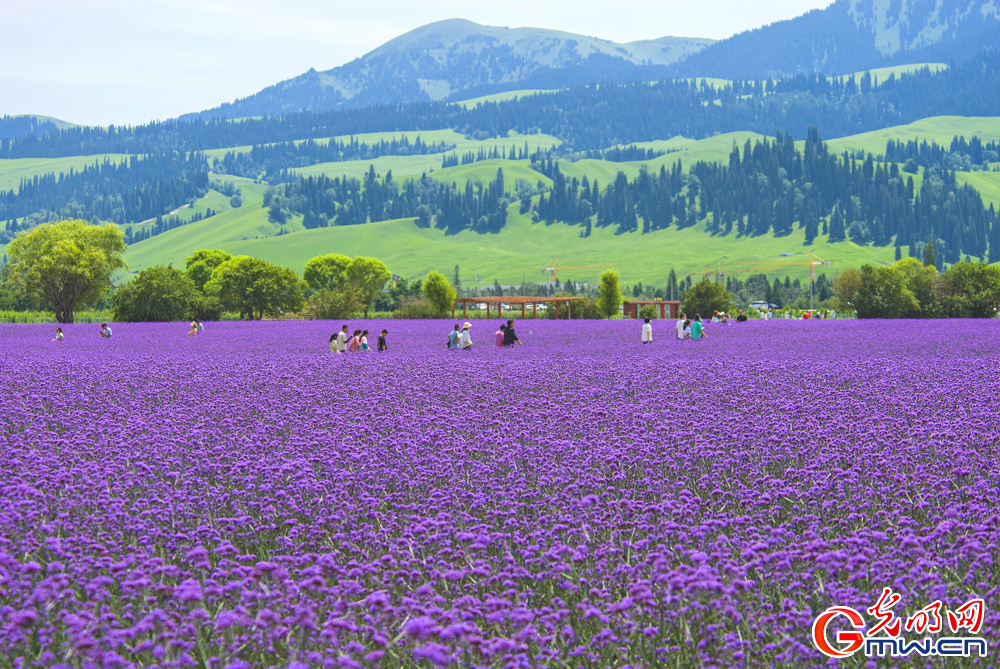
Photo taken on on July 11, 2022 shows the beautiful landscape of Nalati grassland in Xinjiang Uyghur autonomous region. (Photo/ Guangming Picture)
On this breathtakingly beautiful grassland lives 35,000 Kazakh shepherds. Locals say each household owns “3 houses and 1 card”: an apartment in town, a yurt on the grassland, and a cottage on the grass slopes facing the sun; each household here owns hundreds of sheep, dozens of horses or cattle, which are jokingly referred to as the “mobile bank card on the grassland” because each is worth no less than 1 million yuan. Our tour guide Gosal Dotaioli’s family owns more than 300 sheep, more than 70 heads of cattle and horses. Her family hired a herder to help, so the only job left for her is to count the heads once a week.
Gosal told us that Kazakh customs and culture are unique and charming. Marriage is full of poetic romance, young men and women can find their love through the “girl chasing” in grassland dancing and party games. The first baby of the newlywed couple is presented to the grandparents to raise, and the baby would call his grandparents “dad” and “mom”. This is an ancient Kazakh tradition and an expression of gratitude to the elder generation. The “Black Walking Horse” is a folk dance that every Kazakh knows, and sheep catching and horse racing are the favorite athletic activities of the Kazakhs, their folk songs are melodious and passionate, with beautiful tunes and rugged exuberance....Today, “girl chasing”, “black walking horse”, “sheep catching” and many Kazakh folk songs have been put on the national intangible cultural heritage list.
In the east corner of the Nalati grassland, there is a professional horse racing cooperative formed by the herdsmen of Alashan village. The team has a total of more than 150 horses donated by villagers in the cooperative. On an ordinary day the team would practice traditional Kazakh horse racing and sheep catching. During tourism season, they could earn a good revenue. “Without the CPC, there wouldn’t be such happy life”, the herdsmen in the village said.
“People call me Mayra, Mayra the poet; with white teeth and a good voice, Mayra the singer”. Listening to the cheerful songs of the shepherd girl, looking at the flock of sheep like white clouds floating by, the cattle and horses at ease, and the white tents with cooking smoke, isn’t it obvious to all that this is the best protection of ethnic culture?
For thousands of years, various ethnic groups have lived with and learned from each other in Xinjiang, leaving behind a rich and colorful cultural legacy with distinctive ethnic characteristics. The exotic culture and spectacular beauty of all ethnic groups in Xinjiang are just overwhelming.
Today, there are 5,425 intangible cultural heritages and 5,632 certified inheritors in Xinjiang. It is extremely rare to see in other places of the world where intangible cultural heritages are as spectacular as in Xinjiang. And our reporters are more than overwhelmed after seeing only a few of them:
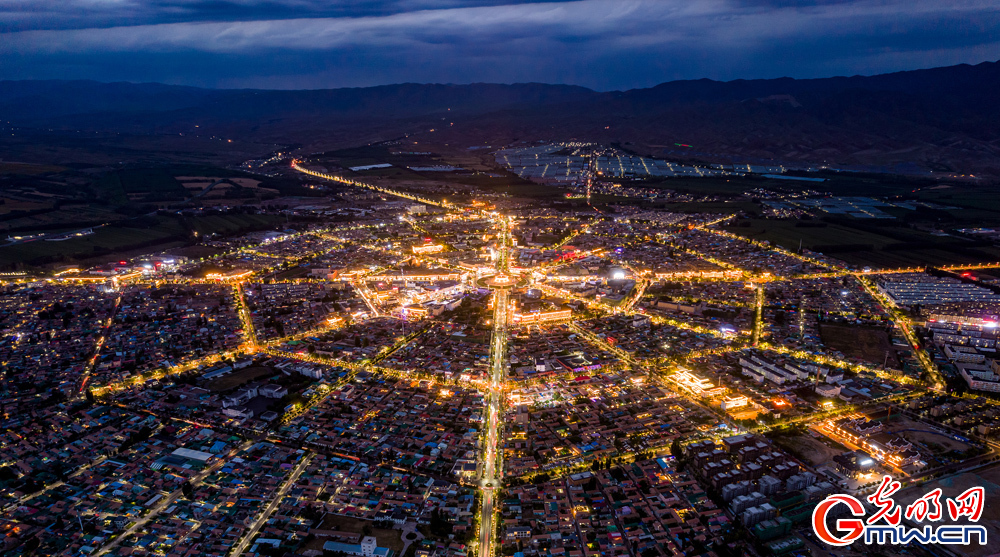
Aerial photo shows the night view of Tekes County, which is designed as a shape of Bagua or Eight Trigrams in northwest China's Xinjiang Uygur Autonomous Region.(Photo/ Guangming Picture)
In Tekes County, Ili Prefecture, where the “Eight Diagrams City” is known across the country, we met 61-year-old Shargan Aoguai, a national intangible heritage-bearer of “Manas”. He started to learn the heroic epic of the Kirgiz people from his grandmother when he was 10 years old. Shargan has been singing “Manas” for 50 years on major festivals and gatherings with a local string instrument called “kumuz”, sometimes for three days and nights straight. “General Secretary Xi Jinping also heard my ‘Manas’ during his visit to Xinjiang not long ago, which was a great inspiration to us. I want to sing ‘Manas’ for the rest of my life, so that the heroic epic can be passed down from generation to generation,” he said.
Adlai silk is synonymous with beauty, not only loved by women of all ethnic groups in Xinjiang, but also a treasure in the eyes of the world’s top fashion designers. It is gorgeously soft and light, and is known as a “living fossil” of the Silk Road. The short video series of “I am Xiaobu, I speak for Adlai” by Hotan girl Buwei Zorizhan Metiruz has gone viral on the internet. We followed “Xiaobu” into the silk town of Gia Township, Hotan City, and saw how silk was made from cocoons, weaved into thread, tie-dyed naturally, and then weaved into silk by hand. Because of the intangible heritage skill, Hotan has gathered a large number of people who live a life as colorful as the Adlai silk.
In the village of Tawankwu Cusak in Shufan County, Kashgar Prefecture, you can hear the sound of instrumental music with strong Xinjiang ethnic styles from afar. This is the “Xinjiang Ethnic Musical Instrument Village”, a title given by China’s State Council. In an instrument workshop, we saw how craftsmen such as Rehman Abdullah, with their dexterous hands, magically transformed mulberry wood, cow horn and sheep skin into beautiful musical instruments. A 4.7-meter-long dutar tells the legend of Xinjiang’s ethnic musical instruments with its spectacular appearance. It was made by Uncle Rehman and his 18 apprentices in 45 days. Uncle Rehman learned the skill from his grandfather and father from the age of 6, and now it’s been 60 years. Today, Rehman’s biggest wish is to pass the craft to his sons and grandchildren.
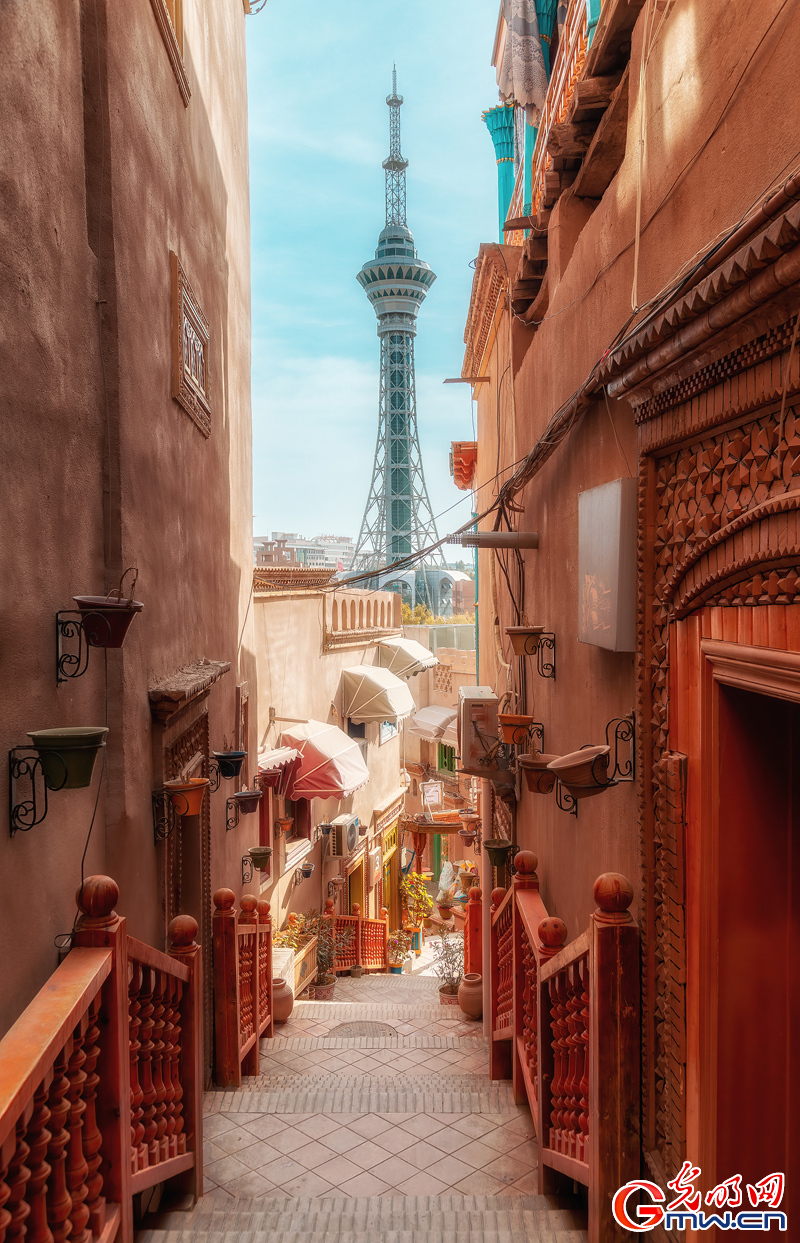
Photo shows the scenery of the ancient city of Kashgar, northwest China's Xinjiang Uygur Autonomous Region. (Photo/ Guangming Picture)
In July, the ancient city of Kashgar is crowded with tourists. What were the earthen tiled and yellow-walled vernacular buildings really like? Certainly there were the staggered alleyways with colorful paintings, the dazzling boutique stores, the Shule City described by Zhang Qian in Western Han Dynasty, the Shule Governor Mansion in Tang Dynasty, and Kashgar, who governed the eight cities in southern Xinjiang in Qing Dynasty… what were they really like? The present-day Kashgar offers a window for endless imaginations.
Located in a seismically active zone and had been in a state of dilapidation, the city of Kashgar underwent a thorough renovation in 2010, and waved goodbye to the old days when “sewage was disposed by evaporation, garbage blown away by wind, and water pipes were hanging on the wall”. After renovation, the millennial city was reborn, and Kashgar has reclaimed its glory of the past. No wonder the UNESCO praised it as “a model of old city preservation and renovation in the world” and the city has become a national 5A-level scenic spot.
In Kashgar Old Town, the folklore store “Guli’s House” is an epitome of Uygur hospitality. Ladies dressed in Adlai silk costumes welcome guests with big smiles, the 80-year-old Simayi Sadiq, wearing a lined lapel robe, gave an ebullient dance on the Gate Opening Ceremony of the Ancient Kashgar City. On one side is the tinkling sound of handicraft stores forging copper pots and horse shoes, on the other side is the tranquility of earthenware artists making jars and utensils. Azeff Jiang Abdurey, a pottery shop owner, told reporters that he was already the sixth generation of earthenware craftsman, and he could earn more than 40,000 yuan a year with the craft.
If Kashgar in the day is ancient, Kashgar at night is modern. Walking along the “Kashgar Impression” street at night, bar singers perform classic songs of various ethnic groups, and the teahouses, restaurants and cultural bazaars are crowded with people, showing the unique youthful vitality of this ancient city.
Who would believe the slander that Xinjiang is a “cultural desert” when you are part of this glowing colors? A trip into Xinjiang makes one wonder who on earth is causing “cultural genocide”?
Before the arrival of white settlers, there were 5 million American Indians living on the continent. After centuries of slaughter, enslavement and deportation, by the end of the 19th century there were fewer than 240,000 of them, and it wasn’t until 1924 that they were recognized as American citizens.
American Indians were portrayed as barbaric, evil, and inferior people, and were the subject of the “Americanization” campaign. Their civilization developed over millennia was devastated. The so-called “reservations” are nothing but a fake government gesture of “cultural preservation”, under which American Indians were segregated and “kept in captivity”.
During the US invasion and occupation, 170,000 artifacts from the Iraqi Museum, one of the top 11 museums in the world identified by UNESCO, were plundered and human civilization was devastated. The US is suppressing, insulting and bullying Middle Eastern countries, seriously undermining the cultural confidence of Middle Eastern countries and people, and destroying their national pride and self-confidence.
“Culture” and “civilization” are such beautiful words, but only through equality, mutual appreciation, dialogue and tolerance can human beings transcend barriers and conflicts. Cultural coexistence must transcend the so-called “cultural superiority” so the garden of human civilization can remain colorful and diverse.
V
The founding of New China has made equality for all people and all ethnic groups in Xinjiang a reality. Under the leadership of the CPC in the new era, a beautiful chapter of Xinjiang featuring equality is being written. Xinjiang is the common home of all ethnic groups, and the beauty of Xinjiang is created by the people of all ethnic groups together. Equality is a pillar underlying the mansion of vitality in Xinjiang today.

Two dancers perform at an intangible cultural heritage exhibition in Hami, northwest China's Xinjiang Uygur Autonomous region, Aug. 2, 2022. (Photo/ Guangming Picture)
It is humanity’s great aspiration that all people are born equal. From “The Book of Rites”, which states that “the way of the world is public”, to Sun Yat-sen’s ideal of “the world is for everyone”, the simple idea of equality for all has been around for thousands of years.
It is an obvious fact that the people of Xinjiang have been suffering from harsh natural conditions and the threats from imperialist powers, and equality for all was once an unattainable luxury. In New China, the basic principles of ethnic equality, ethnic unity and the common prosperity have been adopted as the basis for solving ethnic problems and handling ethnic relations, and the system of regional ethnic autonomy has been implemented.
During our trip to Xinjiang, the autonomous region held its 76th special news conference, which comprehensively introduced that since the 18th CPC National Congress, Xinjiang has resolutely implemented the Party’s strategy in the new era, adhered to the people-centered development concept, and focused on solving problems that people are most directly concerned about, and that the people of all ethnic groups have significantly enhanced their sense of gain, happiness and security.
We traveled from the south to the north of Xinjiang, saw people wearing big and confident smiles, and felt dearly that the peaceful social atmosphere and the ethnic relations are like pomegranate seeds clinging together. Isn’t this the best illustration of equality? The following stories, among many, offer a glimpse into the picture of China’s ethnic equality policy in Xinjiang.
Story 1: 60-year-old retiree Aziguri Abula is a member of the Starlight Choir in the Guyuan Community, Tianshan District, Urumqi. Her husband died 10 years ago, leaving three children behind. The choir is a large family providing her with warmth and care. The choir has members from six ethnic groups, who sing and dance together, and are as intimate as a family. Not long ago, CPC General Secretary Xi Jinping inspected the community, and Aziguri and her sisters shouted together, “Hello, General Secretary!” Aziguri said, “I did not realize I broke in tears, and they were tears of joy and inspiration, and I’d cry whenever I think of the scene. There are more than 4,600 people in our community, each one is a pomegranate seed, and we are all holding together tightly. I will continue singing the song of happiness here with my sisters”.
Story 2: Nurman Guli Ruzemeti was born in late 1980s. Her father kept a 50-year-long friendship with a Han Chinese brother in Guangzhou, and this left a profound impact on Nurman Guli. She first studied at a high school in Shanghai, then went to Xi’an Shiyou University. After graduation, she returned to her hometown of Hotan to work in the community in Nurbagh. Her success is the result of ethnic equality. In 2016, when her daughter was less than two years old and her son less than 8 months old, she came to Tushala Township as a resident official, making greater contributions to ethnic unity. In 2019, she returned to her community and became its director, continuing her service for people of all ethnicities. “All family members of ours are Party members, and I will dedicate the rest of my life to the great cause of ethnic solidarity”, she said.
Story 3: 33-year-old Nur Nisha Alif is the youngest doctoral supervisor at Xinjiang Medical University. At 14, she entered the a high school in Wuxi, and has been studying outside of Xinjiang ever since. In 2019, after graduating from Zhejiang University with a PhD, she chose to return to Xinjiang despite many high-paying job offers. Now she serves as director of the Institute of Biomedical Engineering at Xinjiang Medical University. She always says that the Party’s ethnic policy is like sunshine and rain, and she is just one of the countless beneficiaries. She was the first person to have brought biomedical optics to Xinjiang. She said that “Xinjiang today offers equal opportunities to all those who work hard, and I will live up to the expectations of the Party and the people by fulfilling my mission”.
Story 4: Hao Xiangli, secretary of the CPC branch of Jianggs Village, Yumin County, Tacheng Prefecture, was born in the 1980s. She has been working on the post for three years, supported 39 rural revitalization projects, and built a special rural experience park for Generation Y, transforming the village into a famous tourist spot. The locals give her very high ratings, and that’s why she was elected as a representative to the upcoming 20th CPC National Congress. “Party building is a powerful means to achieve the aspirations of all ethnic groups. We ought to better develop our economy so as to bring equal opportunities to all”, she said.
Story 5: In Laika Township, Hotan County, the 7-year-old Uyghur boy whose broken arm was replanted became a household story. The boy accidentally stuck his right hand into the tractor’s pulley while playing, and most of his arm was ripped off. The window for replanting was only 6-8 hours, a ground-air transport relay across 1,400 km was launched as the boy’s life was at stake. An airplane taxied back to the passenger bridge, re-opened its hatch, and passengers aboard offered their seats, and the flight crew offered their full support and careful care along the way; traffic police in Hotan and Urumqi went all out escorting the ambulance to the hospital; Doctors stayed up all night long, and connected the brachial artery successfully, bringing a little boy back to life ...... this thrilling relay of love shows how every life in Xinjiang is cherished with care and compassion.
As we write this, we can’t help but think of the famous speech “I Have a Dream” by Martin Luther King, the leader of the black civil rights movement in the US.
Sadly for him, some 60 years later, his dream remains nothing but a dream. The desert of justice and oppression has not yet turned into an oasis, and out of the mountain of despair, there isn’t the stone of hope; freedom didn’t ring from the mighty mountains, and there is still a long way to go to achieve equality, fairness and justice for all.
Two years ago, George Floyd, a black man, was brutally killed by a white police officer on the street, blacks across the US took to the street, shouting “Black Lives Matter”. But white police brutality has not ended, George Floyds still “can’t breathe”.
Ethnic minorities, and Asians in particular, have increasingly been discriminated against and brutally attacked. There was a 361% jump in hate crimes against Asians in New York City alone in 2021 compared to 2020, and the pain of being a “perpetual alien” is shared by many, if not all Asian Americans. From public education to access to justice, people of color in the US have been systematically oppressed. In some states, non-white students receive about 60 percent less financial aid than white students; statistically, blacks and Latinos are, respectively, nearly 6 and 3.1 times more likely to be incarcerated than whites.
Minority ethnic groups in the US are systematically discriminated against during the Covid-19 pandemic, but mainstream American society turns a blind eye to their sufferings. In March 2020, when asked about “the wealthy gets prioritized in PCR test but the ordinary people have to stand in long lines and may still not get their chance”, Trump replied, “Maybe that’s life”.
White supremacy and racism are in the genes of American culture. And a country like this is always judging other countries.
The Liuxing Street in Yining City is a multi-ethnic neighborhood. When we arrived there, the sun was setting in the Yili River valley, but the lights on the street were already on, tourists roamed from the Russian-style gardens, the Uygur family courtyards and the Kazakh tent restaurants in beautiful ethnic music, and the aroma of daleba bread and roasted lamb permeated the block. In the courtyard where the Galsang flowers were in full bloom, people of all ages dressed in ethnic costumes sang and danced with the tourists in jubilation. You could feel no difference of race or age, and there were only songs, dances and joys.
Our reporters have only seen the tip of the iceberg of ethnic unity, people of different ethnicities are as close as brothers and sisters. In Tacheng, some families have several, even a dozen ethnic identities. If you ask “To which nationality do you belong?” People in Tacheng will proudly tell you, “Chinese nationality!”
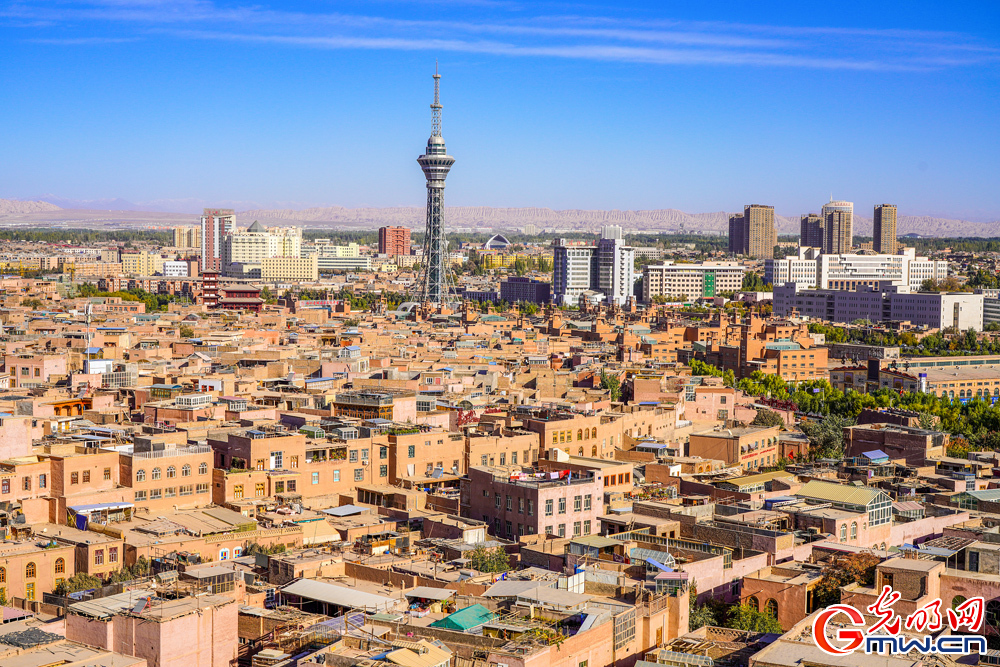
Photo taken shows the scenery of the ancient city of Kashgar, northwest China's Xinjiang Uygur Autonomous Region. (Photo/ Guangming Picture)
Flying from Kashgar to Beijing, we had a panoramic view of Xinjiang from the airplane. When we waved goodbye to Xinjiang, we couldn’t help thinking of the household song “Lift Your Headscarf”.
Didn’t Xinjiang lift her headscarf and show us what she really looks like through this trip?
Yes, this is how Xinjiang really looks like!
(The Guangming Daily Research Team is composed of reporters Wang Huimin, Zhao Jianguo, Guo Lin, Bo Jieping, Li Hui, Shang Jie, Zhao Minghao, Wang Yizhao, Lin Ziyou, Bai Xuelei, Wand Jin, Zhong Chao, Liu Jiangwei, Liu Lu, and GMW.cn reporters Liu Jiaming and Zhang Andi)









